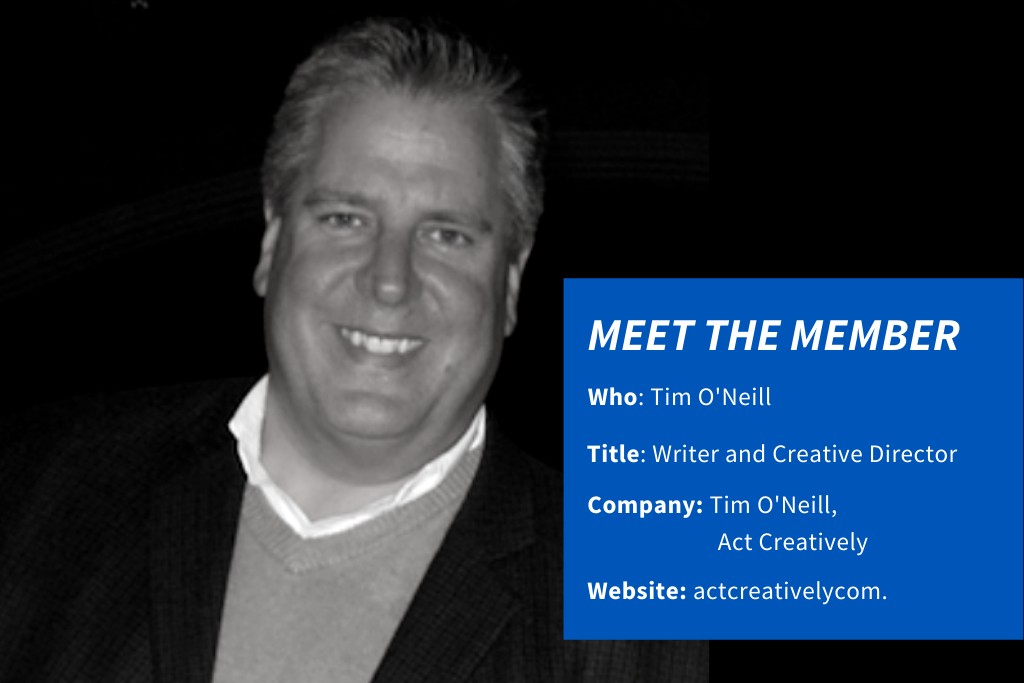by Lindsay Odom
MEET THE AUTHOR: Communications Coordinator and Columbia native Lindsay Odom received her degree from Clemson University before joining the Endeavor team in May 2017. In addition to social media responsibilities, Lindsay is interviewing Endeavor members to learn (and share) more about marketing, agency life, entrepreneurship, and what it means to create meaningful work for clients.

If you’ve met Tim O’Neill before, you probably remember him –– he’s the only member who drives his motorcycle to Endeavor, and if you’ve ever been to a Collaborators & Cocktails event, you know he’s the one who always sits in the front and is the first to ask a question –– usually in the middle of the presentation. I smiled to myself the first time I experience his boldness, curiosity, and confidence.
Those same traits intimidated me when I sat down to interview Tim. But my timidity faded when he started talking about his daughter who’s close to my age. She was getting ready to travel abroad to Ireland. I asked him if he was sad, but to my surprise, he quickly responded, “I’m not sad, because I know she is going to have a great experience.” My heart melted a little –– most parents are sad or even terrified about their children going away for a long time. But I could tell that Tim’s daughter inherited her itch for adventure from her father. After all, travel is what inspired Tim’s talent and career –– the craft of storytelling.
“In 2000, I was a write for a luxury real estate company, at a time when there was a lot of money going into resort real estate. As a writer, you have to understand the product or service before you put words on the page. If I write for a company like ScanSource, I get familiar with the technology to understand what I’m writing about. The same process is done for resort real estate, but I’m playing golf and skiing.”
Kidding aside, Tim explained to me, “the key of branding is creating a story, and everything should come out of that story. Sometimes, we’d begin crafting stories before developers even had a vision for the property. If you have five different golf course communities in Florida, you have to figure out how to stand out rather than saying, ‘this is the best golf course.’ Each community had to have a theme, and every story and message has to be a result of that theme.”
After going from Lake Tahoe to the Caribbean for a few more years, Tim decided to go out on his own…in 2008. “I was freelancing for a property in Tusks & Caicos. Lehman Brothers was going to be the lender. The next morning, I turned on the news to see that they had closed their doors, with pictures of people holding boxes of their belongings outside. The real estate and banking bubble burst, and I thought, ‘I’m not going to get paid.'”

I nodded and bowed my head, prepared to hear the sob story. But just like his response to my question about his daughter studying abroad, I was surprised again by Tim’s positive attitude. “A lot of creatives went out on their own at that time, so there was a community of freelancers who needed a designer, and designers who needed a writer. Client’s couldn’t pay big agencies for their work, but they still needed work done, so they turned to us. We partnered with friends, and although it wasn’t the plan, we knew that if we got through the hard times we could sing through the good times.”
Almost a decade later, Tim is still telling stories, and teaching others along the way. “I’m working on two projects now that started at Endeavor,” he told me. “I met the marketing director for a company looking for a social media manager at Collaborators & Cocktails. I referred her to someone else, because I didn’t think I was the right person for their social media. She ended up contacting me the next week. Her team decided that they need what I do. They needed to refine their story.”
How? By using the same tactic he learned in 2000 and focusing on the individual consumer. “We want to make them proud of the new product. Everyone has their own idea on what their story is, but it’s an art to encapsulate it and grow the story so that marketers and customers can embrace and share it,” Tim said.
Surprised and inspired, I asked Tim my favorite question –– what’s your advice for me? “Well, how about some advice that I disagree with?” he posed. I laughed with a bring-it-on-smile. “I got bad advice one time, which is to get in any way that you can with whatever job you can. For example, if you can’t get a writing job, take a job in media and then move into a writing position once you’re ‘in the door.’ Once you get a job, that’s your label. I say: wait to get a job as a writer if that’s what you want to do. But be flexible. You can always reinvent yourself and then restart, but keep an eye on what it is you really want to do, because you’re going to be doing it for a while.”

